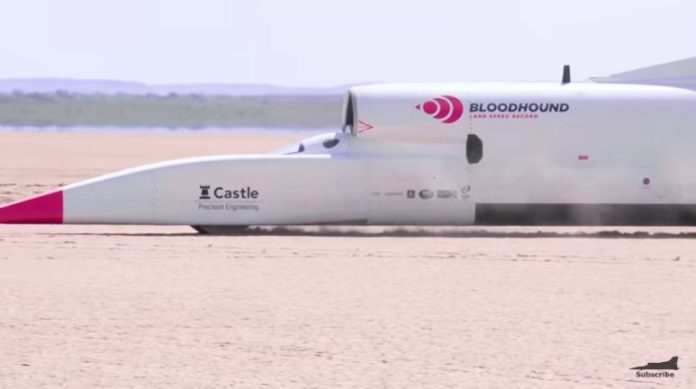The British company Bloodhound LSR conducted another test of the supersonic car, during which it for the first time reached half of the planned top speed, breaking up to 501 miles (806 kilometres) per hour. The aim of the project is to reach a speed of at least 1,000 miles per hour (1,609 kilometres per hour) and set a new speed record on land.
The project was founded in 2008 and was originally called Bloodhound SSC, but at the end of 2018, the developers sold the project to a new owner, after which it was renamed Bloodhound LSR (an acronym for Land Speed Record). The car has a classic for such cars extremely elongated and streamlined body of arrow-shaped, length of 12.9 meters. The weight of the car is 6.4 tons.
The car accelerates two types of engines, responsible for the different stages of the race. Initially, the Rolls-Royce Eurojet EJ200 turbofan engine, which is also installed on Eurofighter Typhoon fighters, is responsible for the acceleration. The car will then include two hybrid rocket engines manufactured by Nammo and accelerate to a top speed that is estimated to be at least 1,000 miles per hour or 1609 kilometres per hour. A combination of two braking parachutes and disc brakes is used to brake after peak speed.
The new race was the 29th test of the car at the bottom of the dried-up lake in South Africa. At this stage, the tests were conducted without rocket engines to achieve supersonic speed. During the race, the car for the first time reached half of the stated maximum speed, speeding up to 806 kilometres per hour.
After reaching peak speed, the car began braking. First, at a speed of 789 kilometres per hour, the first parachute opened, and this was the first test of its modified version. Soon at a speed of 628 kilometres per hour the car released a second parachute. At 322 kilometres per hour, he activated the brakes and stopped, covering 9.33 kilometres.
In 2020, the developers plan to start testing with rocket engines. If all goes well and the car can overcome the sound barrier and reach the stated speed of 1609 kilometres per hour, it will update the speed record on land. The current record was set in 1997 by the Thrust SSC and is 1,228 kilometres per hour. In addition, in this case, Bloodhound LSR will be only the second car in history to break the sound barrier.
